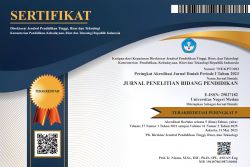MODEL PENERIMAAN TEKNOLOGI MAHASISWA CALON GURU TERHADAP BERBAGAI APLIKASI SELAMA PEMBELAJARAN DALAM JARINGAN DAN KESIAPAN MEREKA MENJADI PENDIDIK BAGI GENERASI Z DAN ALPHA
DOI:
https://doi.org/10.24114/jpbp.v27i2.28329Keywords:
TAM, microteaching, teacher candidates, generation z, generation alphaAbstract
Becoming a professional teacher requires qualified teaching skills. To hone their teaching skills, students are required to take micro teaching courses. During the pandemic, micro teaching courses were carried out online, therefore the course lecturers used various applications for the smooth running of lectures. This study is a descriptive study that aims to analyze student acceptance of the use of various applications in microteaching learning with the TAM approach and then see their readiness as prospective educators for generation z and generation alpha which are known as the very technology literate generation. The study was conducted on 66 students who took microteaching courses even semester 2020/2021. Based on the slovin formula, the samples taken were 57 people. From the results of research data processing, it was found that the average value of the seven successive variables was as follows, 3.21 for distance learning self-efficacy(SE), 2.65 for lack of time (LT), 3.19 for complexity (C ), 3.07 for perceived usefulness (PU), 2.9 for perceived ease of use (PEOU), 6) 3.17 for behavioral intention to use (BIU), and 3.08 for actual technology use (ATU). The results of the analysis show that distance learning self-efficacy is in the high category (indicated by 51 students in the high category, 5 quite low, and 1 low)References
Ariani, D. N. (2015). Hubungan antara Technological Pedagogical Content Knowledge dengan Technology Integration Self Efficacy Guru Matematika di Sekolah Dasar. MUALLIMUNA: Jurnal Madrasah Ibtidaiyah, 1(1), 79“91.
Azwar, S. (2012). Azwar, S.(2011). Metode Penelitian. Yogyakarta: Pustaka Pelajar. Azwar, S.(2012). Penyusunan Skala Psikologi. Edisi 2. Yogyakarta: Pustaka Pelajar.
Buabeng-Andoh, C. (2021). Exploring University students™ intention to use mobile learning: A Research model approach. Education and Information Technologies, 26(1), 241“256.
Chuttur, M. Y. (2009). Overview of the technology acceptance model: Origins, developments and future directions. Working Papers on Information Systems, 9(37), 9“37.
Ginanjar, A. R. (2019). Generasi Alpha dan Pendidikan 4.0. https://kaksetoschool.sch.id/index.php/galeri/32-generasi-alpha-dan-pendidikan-4-0
Jenkins, R. (2017). This is how similar generation z will be to millennials. Luettavissa: Https://Www. Inc. Com/Ryan-Jenkins/This-Is-How-Similar-Generation-z-Willbe-to-Mil-Len. Html Viitattu, 15, 2019.
Kamila, N. (2014). Hubungan Antara Nilai Tugas (Task Value) Mata Kuliah Psikodiagnostik Dengan Orientasi Tujuan Pada Mahasiswa Jurusan Psikologi Fakultas Ilmu Pendidikan Universitas Pendidikan Indonesia [PhD Thesis]. Universitas Pendidikan Indonesia.
Ledger, S., & Fischetti, J. (2020). Micro-teaching 2.0: Technology as the classroom. Australasian Journal of Educational Technology, 36(1), 37“54.
Rakhmah, D. N. (2021). Gen Z Dominan, Apa Maknanya bagi Pendidikan Kita? https://puslitjakdikbud.kemdikbud.go.id/produk/artikel/detail/3133/gen-z-dominan-apa-maknanya-bagi-pendidikan-kita
Rastati, R. (2018). Media Literasi Bagi Digital Natives: Perspektif Generasi Z Di Jakarta. Jurnal Kwangsan, 6(1), 60. https://doi.org/10.31800/jtp.kw.v6n1.p60--73
Ratri, S. M. (2016). Analisis faktor-faktor yang memengaruhi penggunaan e-learning moodle oleh guru SMK Negeri 2 Yogyakarta dengan pendekatan Technology Acceptance Model (TAM). Jurnal Elektronik Pendidikan Teknik Informatika, 5(4).
Saban, A., & Çoklar, A. N. (2013). Pre-Service Teachers™ Opinions about the Micro-Teaching Method in Teaching Practise Classes. Turkish Online Journal of Educational Technology-TOJET, 12(2), 234“240.
Schoen, L., & Fusarelli, L. D. (2008). Innovation, NCLB, and the fear factor: The challenge of leading 21st-century schools in an era of accountability. Educational Policy, 22(1), 181“203.
Stillman, D., & Stillman, J. (2017). Gen Z@ Work: How the next generation is transforming the workplace. HarperCollins.
Sugiyono. (2008). Metode penelitian pendidikan:(pendekatan kuantitatif, kualitatif dan R & D). Alfabeta.
Suki, N. M., & Suki, N. M. (2017). Determining students™ behavioural intention to use animation and storytelling applying the UTAUT model: The moderating roles of gender and experience level. The International Journal of Management Education, 15(3), 528“538.
Tulgan, B. (2013). Meet Generation Z: The second generation within the giant" Millennial" cohort. Rainmaker Thinking, 125.
Zulkosky, K. (2009). Self-efficacy: A concept analysis. Nursing Forum, 44(2), 93“102.
Downloads
Published
Issue
Section
License
Copyright (c) 2021 JURNAL PENELITIAN BIDANG PENDIDIKAN

This work is licensed under a Creative Commons Attribution 4.0 International License.
Authors who publish with this journal agree to the following terms:
a. Authors retain copyright and grant the journal right of first publication with the work simultaneously licensed under a Creative Commons Attribution License (https://creativecommons.org/licenses/by/4.0) that allows others to share the work with an acknowledgement of the work's authorship and initial publication in this journal.
b. Authors are able to enter into separate, additional contractual arrangements for the non-exclusive distribution of the journal's published version of the work (e.g., post it to an institutional repository or publish it in a book), with an acknowledgement of its initial publication in this journal.
c. Authors are permitted and encouraged to post their work online (e.g., in institutional repositories or on their website) prior to and during the submission process, as it can lead to productive exchanges, as well as earlier and greater citation of published work (See The Effect of Open Access).

